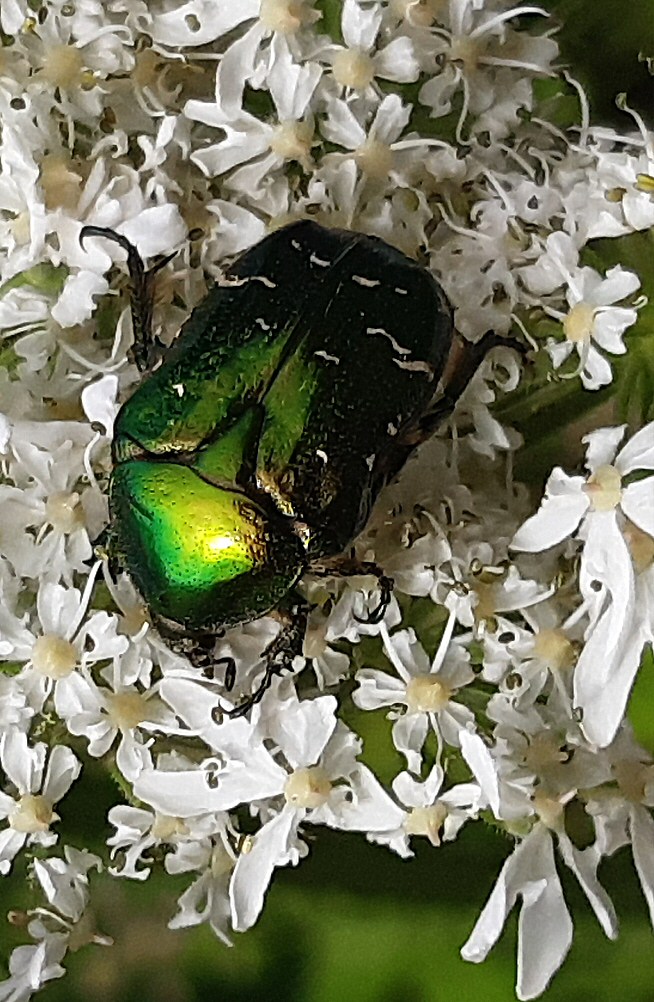
Suddenly it’s Summer!


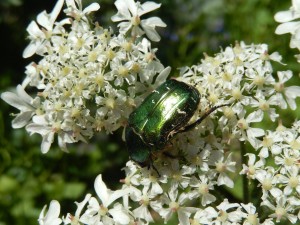
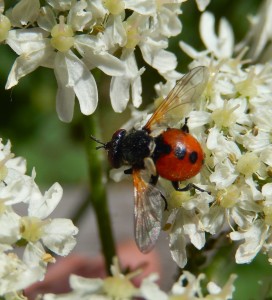
On this lovely hot day, we tried to work, hammering in pegs to fix path edging poles. When we were all a bit dizzy from the heat and effort, we gave up swinging the sledgehammer and had a tea in the hut. Then we did a butterfly transect, which in the absence of anything but Speckled Woods, turned into a nature walk as we photographed all the other interesting insects. The Rose Chafer (on hogweed) is worth looking at full-screen as it’s very pretty.
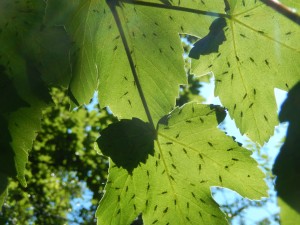
These aphids looked amazing with the sunlight streaming through the leaves; the leaves below were spattered with sticky sugar dropped by the aphids.
There was a beautiful Click Beetle too (like Athous haemorrhoidalis) but I didn’t photograph it as we were having too much fun making it go click and jump out of our hands.
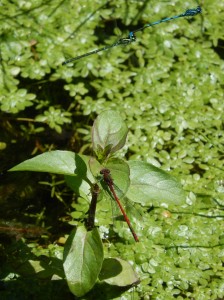
See the Red damselfly? Look up: there’s a pair of Azure damselflies hovering above. Well worth viewing full screen.
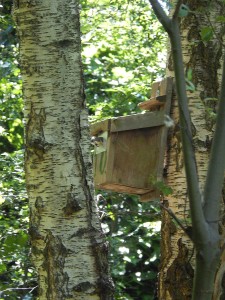
We were pleased (and somewhat surprised) to find a family of Great Tits in box 10, right beside the path, and not terribly high up either, but it was an old and presumably proven nest-site, and so it has proven again this year. I got a blurry photo of one of the proud parents entering the hole, which I had repaired with some aluminium sheet this winter.
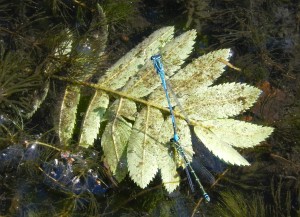
I was very pleased with this photo, with its surreal light and bubbles. I’ve not remarked the green female morph before: most Azure females seem to be a paler, more lime-green form.
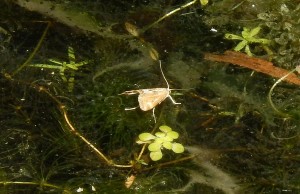
This last photo (taken at quite a distance) shows something very curious: the Brown China Mark, a micro moth that lays its eggs on pondweeds, scurrying over the surface of the water searching for suitable ovipositing sites. In the dazzling light, she was far more reflective than anything else, and I had to turn the exposure down two whole stops to get her about right. The larva is aquatic, feeding on pondweeds.
Not pictured: sawflies; a swift Ichneumon beside the pond (without a long ovipositor, but with a clearly clubbed abdomen); many bumblebees and striped hoverflies. Nests of Peacock butterfly caterpillars too.
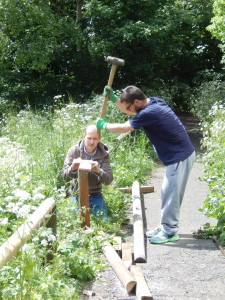
On a lovely May day, we replaced quite a bit of wooden railing, the rail mainly being fine but several of the posts having rotted at the base.
As we worked, a pair of Brimstone butterflies flew nearby, as well as a few Orange Tips, a Red Admiral, a couple of Holly Blues, and a Large White. It was very pretty among the cow parsley, green alkanet and garlic mustard, with visiting bees and hoverflies. A couple of brilliant metallic green Rose Chafer beetles flew over, just above the tops of the cow parsley.
Around the reserve, newly-fledged robins and jays were hopping about unsteadily. A blackcap sang sweetly; a blackbird, a wren and some robins chattered in alarm from a thicket, mobbing a predator, apparently a magpie — most probably as it threatened to rob a nest of eggs or young.

Above the pond, Azure Damselflies and Large Red Damselflies were in cop and egg-laying (both species); up to three male Small Reds at a time were dashing about in tiny dogfights.
There were Dryad butterflies all over beside the paths on the fen peat of the Tourbières, the old peat workings (the French word Tourbe is cognate with our ‘turf’, a block of peat for the fire).
Turtle Doves cooed peacefully as we arrived, and continued the whole time.
Vendoire is one of the best wet meadow areas in all of Aquitaine, with its shallow fen pools and alkaline peat making it a wonderful place for dragonflies. Today, there were Keeled Skimmers all over, making local dashes low over the water; Blacktailed Skimmers here and there, dashing about widely; a pair of Emperors; Scarlet Darters fiercely territorial; White-legged damselflies; Common Bluetail damselflies; Banded Demoiselles; some Small Pincertails on the chalky entrance path.
Marsh Frogs, Rana ridibunda, lived up to their Latin name (‘laughing frog’) with hilarious, loud laughing song (“what’s that bird?”) during our picnic. Around the peat-ponds are woods and Carr of Ash, Alder, Willow, Sallow, Alder Buckthorn, and wet meadow with long grass rich in flowers.
A single Hobby came overhead, its slender Swift-like wings scything, presumably hawking for dragonflies. A Rose Chafer whirred heavily into the air from the scented Meadowsweet and Purple Loosestrife.

Among the butterflies, Large Skipper, Dryad, Gatekeeper, Mallow Skipper, Meadow Brown, Speckled Wood, Common Blue, Holly Blue. The attractive and common micro-moth Pyrausta purpuralis too.
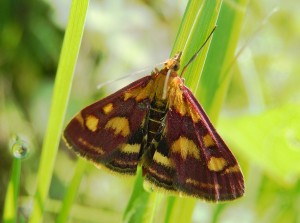
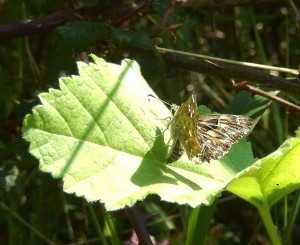
Plateau d’Argentine
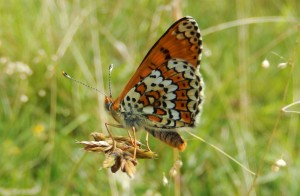
This wonderful reserve, if such it is – it’s still used to launch aircraft, not military any more but hang-gliders – is a flat bare plateau of hard limestone, topped with dry calcareous grassland and scrubby trees, rich in flowers like Viper’s Bugloss, Horseshoe Vetch, Knapweed, Autumn Squill, Eyebright and Devilsbit Scabious, as well as Orchids in springtime, and alive with butterflies. The temperature reached 33 degrees on this sunny afternoon, the Common Blue and Glanville Fritillary butterflies seemingly unaffected by the heat.
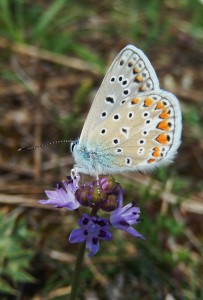
Back at base, a hairy black-and-red striped beetle, Trichodes alvearius visited the Fennel, remaining wary of approach. The very large, black-and-yellow-legged Sand Wasp did the same; it’s tricky to observe as its eyesight is so good.
Saturday 31 May was Bugs Day at Gunnersbury Triangle. The team arrived early to set out home-made cakes, lemonade, a face-painting stall, tables for children to paint butterfly cut-outs, signs advertising the day, and a wall-sized display of the Tree of Life, or rather a Tree of Invertebrate Phylogeny.
Throughout the day a succession of families with small children came and had fun decorating the butterflies.
The Tree of Life occupied a whole wall of the tool shed.
For the first time, we carried out a worm survey, organised nationally by Riverford organic farms (there’s a free identification guide to print out) – bizarrely, there is no map of the distribution of our native earthworms, so perhaps in a year or two there will be one now. We found no ordinary Lumbricus terrestris (Lob worms), the big ones that burrow deep under lawns (, maybe we needed to dig deeper), but good numbers of Black-headed worms (Aporrectodea longa, dark head, brown body, long and thin), a few smallish Green worms (Allolobophora chlorotica), and a Grey worm (Aporrectodea caliginosa, grey with a pink head and a pale saddle). It was surprising how many individual worms there were in a spadeful of earth, and the number of species. Darwin showed how important the earthworm was, but they seem to have been quite thoroughly neglected ever since.
An entomologist from the Natural History Museum led a guided walk on the bugs to be found in the reserve.

We gingerly plucked banded land snails from some tall stinging nettles, finding a good range of colour varieties from clear yellow to heavily striped with dark brown and black.
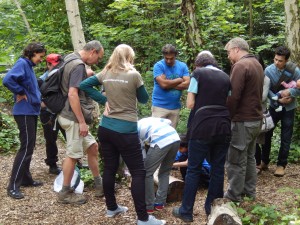
In the woodland, the entomologist boldly ventured outside his special area (Diptera) to familiarise visitors with the range of local slugs, centipedes, millipedes and woodlice: bugs in the very broad sense. We did have some true bugs too: shield bugs that give off a warning stink when held between finger and thumb. And in between, ‘bugs’ often means insects in general.
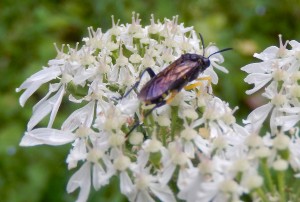
The sawflies and ichneumon flies are difficult for non-experts as there are hundreds of similar species and no popular books. However, the sawflies have thick cylindrical bodies, whereas the ichneumons, like the social wasps, have a very narrow ‘waist’. The Hogweed flowerheads (very large white umbels of dozens of small flowers) played host to plenty of good big sawflies with yellow legs and waspish black-and-yellow stripes.
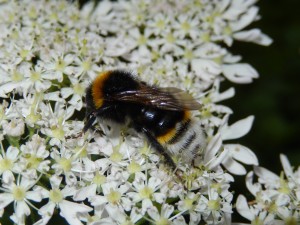
A keen amateur entomologist (who recalled visiting the Triangle before it became a reserve 31 years ago) found this Cuckoo Bee. It parasitises and resembles ordinary bumblebees such as Bombus hortorum, but it never makes a nest or raises young. Instead, the females enter a bumblebee nest that already has a good number of worker bees, displace their queen, and lay their own eggs. Their brood is then brought up by the host workers. It’s a nasty way of life. The adults have a rather distinctive ‘tail’ with less ‘fur’ than usual.
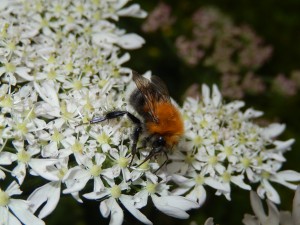
The Hogweed was also feeding plenty of Tree Bumblebees, a smallish species with a bright orange-brown furry thorax and a black abdomen tipped with white, so they are distinctive and easy to recognise. Only ten years ago or so they were unknown in England, but common just across the channel. They seem to have arrived all by themselves – bumblebee expert Dave Goulson (see Book Reviews) found them by chance in the New Forest – and now they are common here. Perhaps their northward spread is part of a global drift of species and habitats towards the poles as the climate warms.
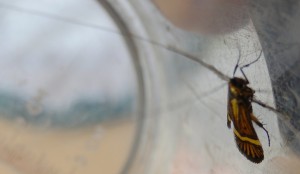
The entomologist found this beautiful micro-moth, giving the lie to any idea that they are all small and brown. Nemophora has a bold yellow-orange stripe across its forewings, making it instantly recognisable, but even more impressive are its antennae, which are over 4 times as long as its body (fw: 10mm): the longest antennae of any British moth. Quite a surprise.